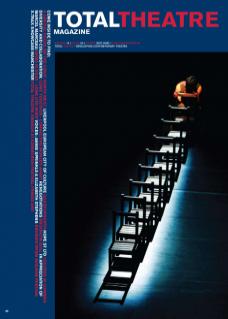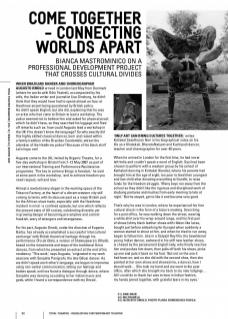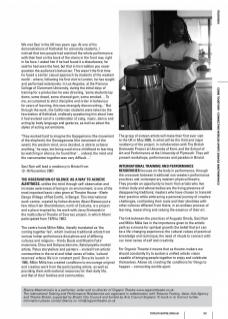WHEN BRAZILIAN DANCER AND CHOREOGRAPHER AUGUSTO OMOLÚ arrived in London last May from Denmark (where he works with Odin Teatret), accompanied by his wife, the Italian writer and journalist Lisa Ginzburg, he didn’t think that they would have had to spend almost an hour at Heathrow airport being questioned by British police. He didn’t speak English, but she did, explaining that he was an artist who had come to Britain to lead a workshop. The police seemed not to believe him and asked for physical proof, which he didn’t have, so they searched his luggage and fired off remarks such as: how could Augusto lead a workshop in the UK if he doesn’t know the language? So why exactly did this highly skilled classical dancer, born and raised within a family tradition of the Brazilian Candomblé, attract the attention of the Heathrow police? Because of his black skin? Let’s hope not!
Augusto came to the UK, invited by Organic Theatre, for a five-day workshop in Bristol from 7–12 May 2007 as part of our International Training and Performance Residencies programme. ‘The key to achieve things is freedom,’ he said at some point in the workshop, ‘and to achieve freedom you need respect, will and love.’
Almost a revolutionary slogan in the working space of the Tobacco Factory, at the heart of a vibrant western city still coming to terms with its obscure past as a major British port for the African slave trade, especially with the Heathrow incident in mind –a confined episode, but one which reflects the present state of UK society, celebrating diversity yet in growing danger of becoming pre-emptive and controlfreakish, wary of strangers and strangeness.
For his part, Augusto Omolú, under the direction of Eugenio Barba, has already accomplished a successful ‘intercultural exchange’ with British theatrical heritage through his performance Ôro de Otelo, a version of Shakespeare’s Othello, based on the movements and steps of the traditional Orixá dances, from which he presented an extract at the end of his residency. ‘This work,’ says Augusto, ‘originated in my work sessions with Sanjukta Panigrahi, the late Odissi dancer. As we didn’t speak each other’s language, we began to improvise using non-verbal communication, letting our feelings and bodies speak; until we found a dialogue through dance, where Sanjukta was dancing according to her Indian music and gods, while I found a correspondence with my Orixás’.
‘ONLY ART CAN BRING CULTURES TOGETHER,’ writes Kottakal Sasidharan Nair in his biographical notes on his life as a Khatakali, BharataNatyam and Kuchipudi dancer, teacher and choreographer for over 40 years.
When he arrived in London for the first time, he had never left India and couldn’t speak a word of English. Sasi had been chosen to perform with a western group by his school of Kathakali dancing in Kottakal (Kerala), where his parents had brought him at the age of eight, too poor to feed their youngest and last child after donating everything to Gandhi, to raise funds for the freedom struggle. ‘Many boys ran away from the school as they didn’t like the rigorous and disciplined work of studying postures and mudras from early morning to late at night.’ But he stayed, got to like it and became very good.
That’s why he was in London, where he experienced his first cultural shock in the form of a bizarre meeting. Searching for a post office, he was walking down the street, wearing a white shirt over his wrap-around lunge, and his first pair of shoes (shiny black leather shoes with ribbon-like laces, bought just before embarking for Europe) when suddenly a woman started to shout at him, and when he tried to run away, began to follow him. Like in a Satyajit Ray film, the bewildered young Indian dancer, awkward in his stiff new leather shoes, is chased by the perseverant English lady, who finally reaches him and pushes him down, then pulls off both his shoes, picks up one and puts it back on his foot. ‘But not on the one it had been on; and so she did with the second shoe, then she pointed at her own shoes and showed me, a dancer, how I should walk… She took my hand and we went to the post office, after which she brought me back to my new lodgings… All I could do to thank her was to bow in Indian fashion, my hands joined together, with grateful tears in my eyes.’
We met Sasi in the UK two years ago. At one of his demonstrations of Kathakali for university students, I noticed that two people had watched the whole performance with their feet on the back of the chairs in the front row, right in his face. I asked him if he had found it a disturbance; he said he had seen the feet, but that in his tradition you never question the audience’s behaviour. This wasn’t the first time he faced a similar casual approach by students of the western world – where, following his first visit to London, he has taught and performed extensively. In Los Angeles, at the Pomona College of Claremont University, during the initial days of training for a production he was directing, ‘some students lay down, some dozed, some chewed gum, some smoked… To me, accustomed to strict discipline and order in behaviour for years of learning, this was strangely disconcerting...’ But through the work, the Californian students were taken by the fascination of Kathakali, endlessly questioning him about how it had evolved out of a combination of song, music, dance and acting by body language and gestures, as well as about the styles of acting out emotions.
‘They worked hard to imagine the Gajagamana (the movement of the elephant), the Sansagamana (the movement of the swan); the western mind, once decided, is able to achieve anything,’ he says, but being used since childhood to learning by watching in silence, he found that ‘…indeed, the mind and the conversation together was very difficult…’
Sasi Nair will lead a residency in Bristol from 12–16 November 2007.
THE OBSERVATION OF SILENCE AS A WAY TO ACHIEVE ALERTNESS, settles the mind through self-observation and increase awareness of being in an environment, is one of the most important basic rules given at Theatre House - Khele Danga (Village of Red Earth), in Bengal. This international work-centre, created by Indian director Abani Biswas just a few miles from Shantiniketan, north of Calcutta, is a project and a place inspired by his work with Jerzy Grotowski in the multicultural Theatre of Sources project, in which Abani participated from 1979 to 1983.
The centre hosts Milòn Méla, literally translated as ‘the coming together fair’, which involves traditional artists from various Indian performance disciplines and of differing cultures and religions – Hindu Bauls and Muslim Fakir musicians, Chau and Gotipua dancers, Kalaripayattu martial artists, Patua storytellers and painters – invited from artistic communities in the rural and tribal zones of India; ‘cultural reserves’ whose life is in constant peril. Since its launch in 1986, Milòn Méla has created conditions to encourage original and creative work from the participating artists, as well as providing them with material resources for their daily life, and that of their families and communities.
The group of sixteen artists will make their first ever visit to the UK in May 2008, in what will be the third and major residency of the project, in collaboration with The British Grotowski Project at University of Kent, and the School of Art and Performance at the University of Plymouth. They will present workshops, performances and parades in Bristol.
INTERNATIONAL TRAINING AND PERFORMANCE RESIDENCIES focuses on the body in performance, through the crossover between traditional non-western performance practices and contemporary western physical theatre. They provide an opportunity to learn from artists who live in their body and whose bodies are the living presence of disappearing traditions; masters who have chosen to transmit their practice while embracing a personal journey of creative challenges, confronting their roots and their identities with other cultures different from theirs, in an endless process of learning, researching and valuing the essence of their art.
The link between the practices of Augusto Omolú, Sasi Nair and Milòn Méla lies in the importance given to the artistic path as a means for spiritual growth; the belief that art can be a life-changing experience; the cultural values of practical knowledge and technique; the need of rituals to connect with our inner sense of self and creativity.
For Organic Theatre it means that as theatre-makers we should constantly try to sustain a unified artistic vision capable of bringing people together to enjoy and celebrate themselves. Above all, creating the conditions for things to happen – connecting worlds apart.
Bianca Mastrominico is a performer, writer and co-director of Organic Theatre www.organictheatre.co.uk
The International Training and Performance Residencies are organised in collaboration with Tobacco Factory, Asian Arts Agency and Theatre Bristol, supported by Bristol City Council and funded by Arts Council England. To book or to find out further information please contact Bianca on info@organictheatre.co.uk


